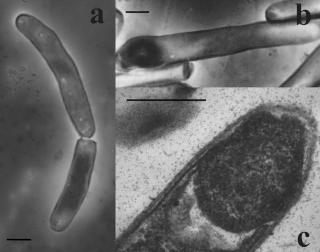
The Bacillota are a phylum of bacteria, most of which have gram-positive cell wall structure. The renaming of phyla such as Firmicutes in 2021 remains controversial among microbiologists, many of whom continue to use the earlier names of long standing in the literature.

Bacilli is a taxonomic class of bacteria that includes two orders, Bacillales and Lactobacillales, which contain several well-known pathogens such as Bacillus anthracis. Bacilli are almost exclusively gram-positive bacteria.

The Clostridia are a highly polyphyletic class of Bacillota, including Clostridium and other similar genera. They are distinguished from the Bacilli by lacking aerobic respiration. They are obligate anaerobes and oxygen is toxic to them. Species of the class Clostridia are often but not always Gram-positive and have the ability to form spores. Studies show they are not a monophyletic group, and their relationships are not entirely certain. Currently, most are placed in a single order called Clostridiales, but this is not a natural group and is likely to be redefined in the future.

The Clostridiaceae are a family of the bacterial class Clostridia, and contain the genus Clostridium.

Erysipelothrix is a genus of bacteria containing four described species, Erysipelothrix rhusiopathiae, Erysipelothrix tonsillarum, Erysipelothrix inopinata and Erysipelothrix larvae. Additional species have been proposed based on DNA-DNA hybridization studies "The hallmark of Erysipelothrix is the presence of a type B cell wall, in which the peptide bridge is formed between amino acids at positions 2 and 4 of adjacent peptide side-chains and not, as in the vast majority of bacteria, between amino acids at positions 3 and 4."

The Erysipelotrichaceae are a family of Gram-positive bacteria.
The Veillonellaceae are a family of the Clostridia, formerly known as Acidaminococcaceae. Bacteria in this family are grouped together mainly based on genetic studies, which place them among the Bacillota. Supporting this placement, several species are capable of forming endospores. However, they differ from most other Bacillota in having Gram-negative stains. The cell wall composition is peculiar.
The Negativicutes are a class of bacteria in the phylum Bacillota, whose members have a peculiar cell wall with a lipopolysaccharide outer membrane which stains gram-negative, unlike most other members of the Bacillota. Although several neighbouring Clostridia species also stain gram-negative, the proteins responsible for the unusual diderm structure of the Negativicutes may have actually been laterally acquired from Pseudomonadota. Additional research is required to confirm the origin of the diderm cell envelope in the Negativicutes.
The Eubacteriaceae are a family of Gram-positive bacteria in the order Clostridiales.
The Selenomonadales are an order of bacteria within the class Negativicutes; unlike most other members of Bacillota, they are Gram-negative. The phylogeny of this order was initially determined by 16S rRNA comparisons. More recently, molecular markers in the form of conserved signature indels (CSIs) have been found specific for all Selenomonadales species. On the basis of these markers, the Selenomonadales are inclusive of two distinct families, and are no longer the sole order within the Negativicutes. Several CSIs have also been found specific for both families, Sporomusaceae and Selenomonadceae. Samples of bacterial strains within this order have been isolated from the root canals of healthy human teeth.

Carboxydocella is a Gram-positive and obligate anaerobe bacterial genus from the family of Syntrophomonadaceae.
Bulleidia is a Gram-positive, non-spore-forming, anaerobic and non-motile genus from the family of Erysipelotrichidae, with one known species.
Desulfonatronovibrio is a Gram-negative, vibrios, anaerobic and motile genus of bacteria from the family of Desulfohalobiaceae with a single polar flagellum.
Caldalkalibacillus is an aerobic and spore-forming genus of bacteria from the family of Bacillaceae the stains either Gram-positive or Gram-variable. The type species of this genus is Caldalkalibacillus thermarum.
Caldibacillus is a facultative anaerobe genus of bacteria that stains Gram-positive from the family of Bacillaceae. The type species of this genus is Caldibacillus debilis.
Bacteriovoracaceae is a family of gram-negative, comma-shaped bacteria. All members have a two-part life cycle consisting of a free-living motile "attack phase" and a "predatory phase" that lives in the periplasm of other gram-negative bacteria. Bacteriovoracaceae are found in freshwater and in the soil.
Tumebacillus is a genus of Gram-positive, rod-shaped, spore-forming bacteria. Members of the genus can be motile or non-motile, and form white or yellow colonies on R2A agar.
Effusibacillus is a genus of Gram-positive, rod-shaped, aerobic, spore-forming bacteria.
Metabacillus is a genus of rod-shaped bacteria exhibiting Gram-positive or Gram-variable staining in the family Bacillaceae within the order Bacillales. The type species for this genus is Metabacillus fastidiosus.
Thermosediminibacteraceae is a family of Gram positive bacteria in the class Clostridia.





